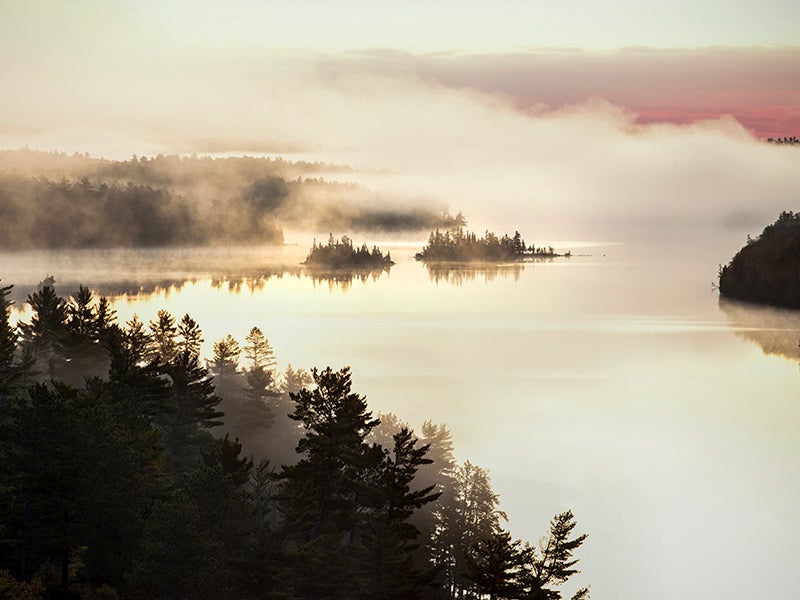Earthjustice stands with western Alaska tribes and families after severe storms devastated entire communities, displacing more than 1,000 residents just before winter. Learn more and how you can help.
We’re Suing to Save a World-Famous Canoeing Wilderness From Mining Pollution
There are 1,100 clear, peaceful lakes in Minnesota’s Boundary Waters wilderness. The Trump administration wants to add a sulfide mine or two.

This page was published 7 years ago. Find the latest on Earthjustice’s work.
Voyage two or three lakes deep into the Boundary Waters Canoe Area Wilderness and you might not see another human being for a day at a time. Boats with motors are banned in the chain of 1,100 lakes that stretches along Minnesota’s border with Canada, and entry permits are carefully rationed. What’s left is true serenity: the quiet splash of your paddle breaking the surface, the crackle of a campfire, and the haunting call of the loons.
All of that — the clean water, the peacefulness, the 200,000 annual visitors and the boost they bring to Minnesota’s economy — is under threat. Mining leases adjacent to the Boundary Waters threaten to introduce sulfide mining and its inevitable, catastrophic acid discharge that permanently contaminates fresh water.
The leases, first approved in 1966, and renewed again in 1989 and 2004, lapsed under the Obama Administration after the company that holds them failed to win a third renewal. In a 2016 letter rejecting the renewal, the chief of the U.S. Forest Service noted that operating a mine near the Boundary Waters “might cause serious and irreplaceable harm to this unique, iconic, and irreplaceable wilderness area,” a risk he called unacceptable.
But a May 2018 decision from Secretary Ryan Zinke’s Department of the Interior casts new doubt on the future of the Boundary Waters. That decision seeks to reinstate the mining leases (now expired for 18 months) while setting aside the clear and mandated input from the U.S. Forest Service.
On Monday, Earthjustice challenged the Interior Department’s decision to reinstate the leases. The Earthjustice suit on behalf of The Wilderness Society, Center for Biological Diversity, and Izaak Walton League parallels two other lawsuits opposing the leases — one brought by Northeastern Minnesotans for Wilderness and nine local businesses, and another brought by the Friends of the Boundary Waters Wilderness.
The situation is perilous, Earthjustice attorney Erin Whalen says.
“The Boundary Waters is what’s hanging in the balance,” she says. “You can’t say enough good things about the Boundary Waters. It’s one of America’s most visited wildernesses, the crown jewel of public lands in the Midwest, among the largest remaining old growth forests in the Lower 48, and it holds 20 percent of all the fresh water in the entire National Forest System.”
Boundary Waters advocate David Zentner is 82 years old and still regularly fishes the pristine waters of Northeastern Minnesota. Through work with the Izaak Walton League and other groups, and as a board member of the Minnesota Pollution Control Agency, he has been instrumental in the creation and protection of the Boundary Waters as we now know it.
Zentner sees the stakes as sky-high not just for Minnesotans but for Americans and citizens of the world — the Boundary Waters, he says, are a special place because of their status as a living, breathing natural laboratory, as a place for spiritual renewal, and as a massive repository of clean fresh water.
And mining poses a uniquely severe threat to the Boundary Waters because the region’s geology can’t buffer acid from draining from the mines into the watershed, Zentner says.
Whalen says that the agency’s justification for reversing the Obama administration decision is makeweight.
“These leases were issued before our modern environmental laws even existed, and they’ve been expired for almost a year and half,” she says. “The agency has no authority to resurrect them now, and its decision is inconsistent with the leases, plain and simple.”
Amid all the decisions, reversals, and lawsuits, stands something ancient that transcends the process, and people who have fought to defend an irreplaceable place of natural beauty. Zentner summed up the long view on the Boundary Waters: “Somewhere along the line, enough people brought the vision of humility, of protection, of not dominating every acre of water, every mile of river, every hillside of forest. [Instead they] said: ‘Let’s stand down and circle our hands around this wonderful place and show that we’ve learned enough to respect nature and that we don’t need to develop every bit of this planet, and if we do so, we do so at our own peril.’ That’s what it means to me.”
Opened in 1978, our Alaska regional office works to safeguard public lands, waters, and wildlife from destructive oil and gas drilling, mining, and logging, and to protect the region's marine and coastal ecosystems.
The Biodiversity Defense Program fights to reshape our relationship to lands, water, and wildlife everywhere by confronting the major drivers of the decline in nature, including habitat destruction and over-exploitation of wildlife.
Earthjustice’s Midwest office works to partner with and support communities and Tribes fighting for environmental and climate justice. We also aim to protect our region’s precious places and wildlife, and build sustainable energy and climate solutions.